Alessandro Pasqualini
Alessandro Pasqualini (born May 5, 1493 in Bologna , † before September 1559 in Bielefeld ) was an Italian fortress builder and architect in the Netherlands and on the Lower Rhine.
Life
Pasqualini was trained in Bologna and Rome . He then worked at various royal courts north of the Alps. In the Netherlands he entered the service of the Egmond family , for whom he designed the steeple of the St. Nicolaas Church in IJsselstein and took over the construction management for Buren Castle. Since the 1530s he was particularly active in fortress construction , including for the Prince-Bishop of Liège and cities like Amsterdam, Hertogenbosch and Middelburg .
Duke Wilhelm V of Jülich-Kleve-Berg summoned him to the Rhineland in 1549 , so that he could plan the fortifications at its castles and cities that had become necessary due to the new developments in the weapon system. This is where the most important buildings of Pasqualini were built, for example the Jülich citadel and the Jülich town hall. He was also involved in the reconstruction and renovation of the Düsseldorf Palace , in which his new client resided, for example in the palace chapel and the palace tower, which is only preserved today . His work can also be traced in Benrath , Bensberg , Heinsberg and Kleve . According to his plans as a specialist in fortress construction, the Bottmühle was built in Cologne .
On behalf of the Jülich bailiff Johann von Palant , Pasqualini probably devoted himself to the reconstruction of the Nothberg Castle around 1555 . a. Pleasure corridor and bay window. Around 1556 he directed and planned the extension of the Scherpentiner, the western bastion of the Sparrenburg in Bielefeld in the county of Ravensberg , of which Duke Wilhelm was also the sovereign.
Alessandro Pasqualini became the founder of a dynasty of fortress builders. His sons Maximilian von Pasqualini (architect of Rheydt Castle ) and Johann von Pasqualini the Elder were ennobled. They continued their father's work in Jülich on the castle, on the fortress and in urban planning. Johann von Pasqualini also worked on the New Italian expansion of the Orsoy fortress . Alessandro's grandson Johann von Pasqualini the Younger (general builder in Jülich, Kleve, Berg) and Alexander (1567–1623; master builder in the Duchy of Kleve ), both sons of Maximilian, were also fort builders (around 1600 on Ehrenbreitstein fortress , former Rhine crane in Koblenz) active and are particularly often mentioned as appraisers for the fortress construction.
Pasqualini is one of the first modern architects to introduce the elements of the Italian Renaissance and bastion construction north of the Alps.
First draft of the Jülich Citadel
Church tower in IJsselstein
literature
- Günter Bers: The Italian architect Alessandro Pasqualini (1493–1559) and the Renaissance on the Lower Rhine: State of knowledge and research perspectives . Fischer (Jülich), 1994, ISBN 3-87227-051-6
- Guido von Büren: Alessandro Pasqualini: the Italian renaissance on the Lower Rhine .
- Guido von Büren: Palaces and bastions - imported Renaissance: Alessandro Pasqualini (1493–1559) . German Kunstverl., 1995.
- Guido von Büren: Pasqualini, Alessandro. In: New German Biography (NDB). Volume 20, Duncker & Humblot, Berlin 2001, ISBN 3-428-00201-6 , p. 86 f. ( Digitized version ).
- Conrad Doose: Alessandro Pasqualini: a fortress builder, architect and artist of the Cathedral School of St. Peter in Rome and Belgium, Germany and the Netherlands . Fischer (Jülich), 1993, ISBN 3-87227-047-8
- Friedrich Lau: The Pasqualini family of architects . In: Düsseldorfer Jahrbuch 1920/24 , Volume 31, 1925, p. 108 f.
- Theo van Mierlo: Alexander Pasqualini: 1493-1559; Architect and fortress builder in the Netherlands , ISBN 3-9801876-7-5
Web links
- Literature by and about Alessandro Pasqualini in the catalog of the German National Library
- Alessandro Pasqualini (website of the city of Jülich)
- Alessandro Pasqualini: Our castle is a strong castle ( Memento from September 12, 2014 in the Internet Archive ) A short biography in German.
Individual evidence
- ↑ Jochen Rath: August (?) 1559: The architect of the Scherpentiner, Alessandro Pasqualini dies in Bielefeld. Bielefeld City Archives and State History Library, accessed on June 30, 2012 : "It was built by hundreds of workers and designed by the Italian fortress builder Alessandro Pasqualini, who died in Bielefeld before September 1559."
- ^ Van Büren: NDB
- ^ Van Büren: NDB
- ^ Johann Jakob Merlo: Pasqualini, Johann von . In: Allgemeine Deutsche Biographie (ADB). Volume 25, Duncker & Humblot, Leipzig 1887, p. 216.
- ^ Van Büren: NDB
| personal data | |
|---|---|
| SURNAME | Pasqualini, Alessandro |
| BRIEF DESCRIPTION | Italian architect and fortress builder |
| DATE OF BIRTH | May 5, 1493 |
| PLACE OF BIRTH | Bologna |
| DATE OF DEATH | before September 1559 |
| Place of death | Bielefeld |


